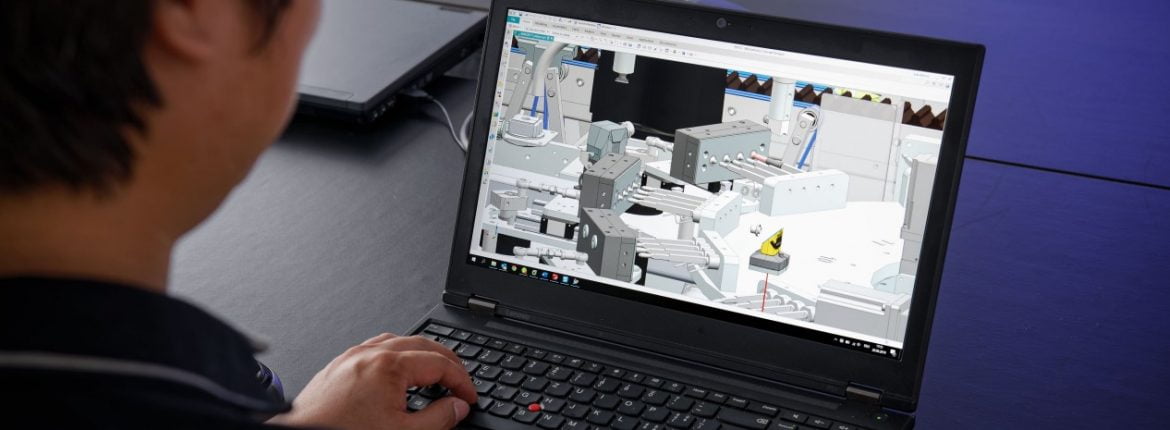
A digital twin allowed Ruggli AG to design and optimize the rotary table of a new machine for manufacturing tampons. This sped up the development of the device and ensured that commissioning went smoothly.
The latest machine from Ruggli AG is a true jack-of-all-trades. It produces tampons for sanitary protection and does everything from manufacturing the applicator to sealing the packaging.
The system combines many functions. The blanks for the applicator, which helps with tampon insertion, first enter the machine on guide belts. Robots correctly orient the raw material and place it on metal spikes on the rotary table, where the multi-part applicator is assembled and thermally formed.
The next machine produces the tampon and inserts it into the applicator, which is sealed by heating. Finally, the sanitary product is packaged in a tubular bag. Several cameras continuously check the quality of each piece and remove defective products.

The multifunctional machine manages a mix of materials.
A machine of this type is something new even for Ruggli AG, although the company has been developing and building customer-specific tampon-manufacturing machines for more than 50 years. Not only is the applicator a new product, but the device also stands out thanks to the high integration of different functions and the ability to process a variety of materials.
Ruggli’s approximately 40 employees in Koblenz, Germany, handle everything from manufacturing to commissioning to sales and service for their customers. As the only manufacturer of comparable systems, the Koblenz-based company ships its products all over the world.
“The requirements and specifications for new orders are becoming more and more complex, while time pressure continues to increase,” says Samuel Schuler, Head of Research & Development at Ruggli. “Customers often want their new machine delivered and to begin producing tampons in just a few months.”
The requirements and specifications for new orders are becoming more and more complex, while time pressure continues to increase.
Samuel Schuler, Head of Research & Development, Ruggli AG
Overcoming time pressure with a digital twin
To meet the challenge of ever-shorter development cycles, Ruggli and Siemens rely on the digital twin’s support. There’s particular potential for collisions inherent in the rotary table used for producing the applicator. The table has spikes mounted all around it for holding the blanks. The table moves forward every two seconds, and 120 applicators that will later be placed over the tampons are produced every minute.
Once Ruggli’s developers had finished designing the machine, Siemens suggested that they create a digital twin of the rotary table. “The rotary table’s movement is tricky, and we wanted to test it thoroughly,” says Suy Siang Te, Application Engineer at Siemens Digital Industries.

Experts from Siemens’ long-standing PLM partner BCT Technology GmbH conducted workshops and training courses on-site. They were able to win over the customer to the NX Mechatronics Concept Designer (MCD).
The rotary table’s movement is tricky, and we wanted to test it thoroughly.
Suy Siang Te, Application Engineer at Siemens Digital Industries
Simulation avoids collisions
Ruggli provided the CAD data, and Suy Siang Te and his team configured the movements in MCD. This allowed the engineers to determine whether the calculated cycle periods were realistic and where collision risk could be found. Due to time pressure, three software developers worked on the project at the same time.
“When it came to programming, we had to consider the controllers of three machine components and two robots,” Suy Siang Te explains. “We needed to integrate software from at least five different providers, and the system had to operate as a whole, of course.”
The digital twin simulates even complex processes.
The digital twin is the right choice for these complex tasks involving multiple stakeholders. The twin’s one-to-one representation of the mechanical components has the benefit of allowing the functionalities to be checked visually. This simplifies communication among everyone involved and prevents misunderstandings.
The virtual tests also eliminate the danger of collisions. For example, if the X and Y axes of a movement are mixed up by mistake during programming, this becomes immediately apparent in the digital image. An error of this type would be devastating in a real machine.

Virtual inspection of the overall system
It’s not just the machine’s mechanical components that can be inspected digitally; the interfaces can also be defined, the controller programmed, and the safety functions tested using the digital twin as well. The programmers also integrate motors and signals from light barriers and thereby push the entire system.
Without the twin, the complex interplay between the components could only be tested at a very late point in development on the real machine. Schuler has only good memories of the development work. “We brought Siemens on board at an early stage, which meant that the areas of responsibility were clear from the very beginning. We were always able to communicate openly, which I very much appreciated.”
The digital twin cuts development time by 20 percent
About one year passed from the start of development to the beginning of the assembly. Using the digital twin significantly reduced the time needed for programming. Suy Siang Te estimates that this approach meant time savings of approximately 20 percent compared with a conventional procedure, including creating the twin. The digital representation is also valuable for future orders because the functionalities can be further developed or adapted as needed.
There were no unpleasant surprises when it came to commissioning the system, thanks to the digital twin. The controller, drives, and the newly developed HMI work together seamlessly and can be conveniently developed, automated, and operated in the TIA Portal. If a problem emerges later on during operation on the end-customer premises, Siemens guarantees support via remote maintenance.

Don’t hesitate to contact Thanh for advice on automation solutions for CAD / CAM / CAE / PLM / ERP / IT systems exclusively for SMEs.
Luu Phan Thanh (Tyler) Solutions Consultant at PLM Ecosystem Mobile +84 976 099 099
Web www.plmes.io Email tyler.luu@plmes.io

